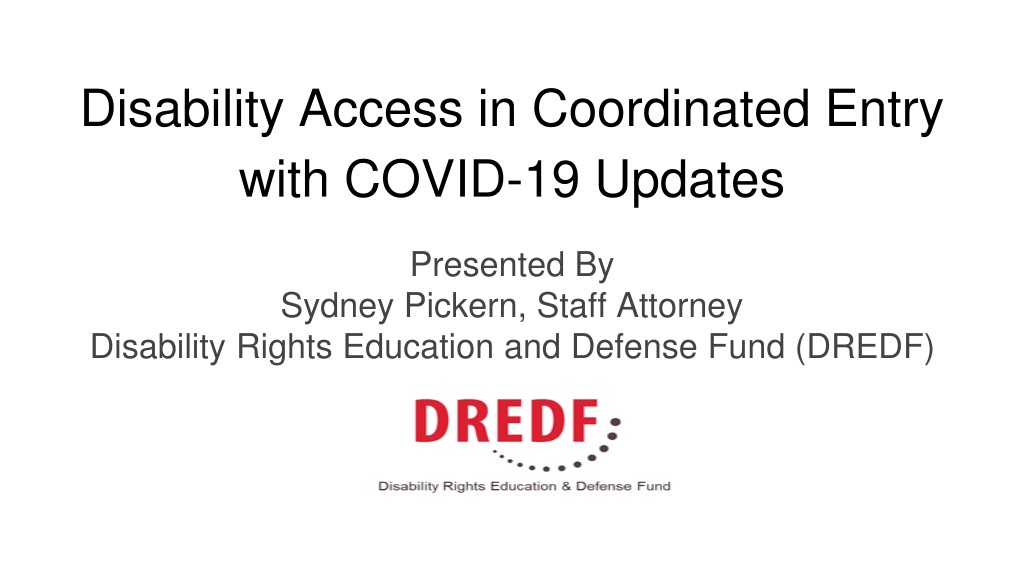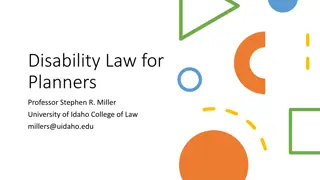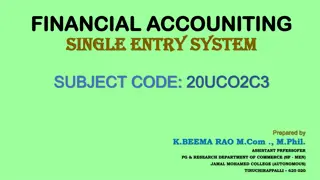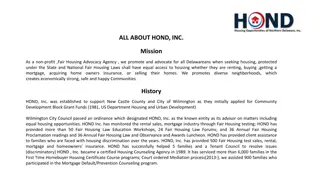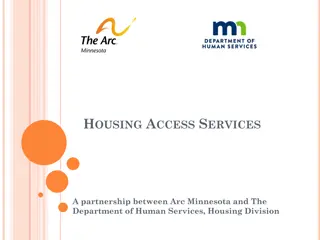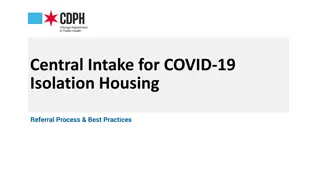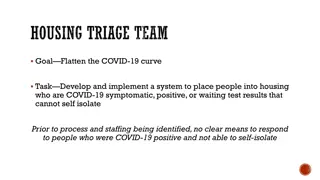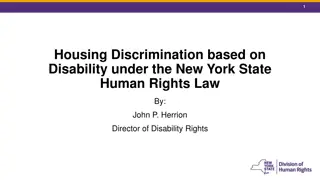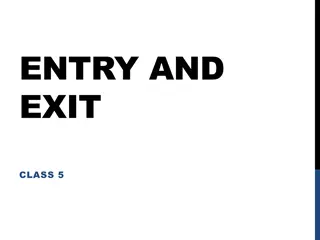Ensuring Disability Access in Coordinated Housing Entry During COVID-19
Addressing the critical need for disability access in housing programs for individuals experiencing homelessness, this presentation discusses the importance of prioritizing people with disabilities and complying with civil rights protections in coordinated entry systems like McKinney-Vento and Continuums of Care. It highlights key factors for prioritization and emphasizes the legal framework of disability civil rights protections.
Download Presentation

Please find below an Image/Link to download the presentation.
The content on the website is provided AS IS for your information and personal use only. It may not be sold, licensed, or shared on other websites without obtaining consent from the author. Download presentation by click this link. If you encounter any issues during the download, it is possible that the publisher has removed the file from their server.
E N D
Presentation Transcript
Disability Access in Coordinated Entry with COVID-19 Updates Presented By Sydney Pickern, Staff Attorney Disability Rights Education and Defense Fund (DREDF)
Why is this Presentation Important? Long standing affordable, accessible housing crisis SSI cost of living Disability status high among people experiencing homelessness Many federal housing programs target this population Disability access barriers Disability and civil rights protections
McKinney-Vento and the Continuum of Care Program Stewart B. McKinney Homeless Assistance Act of 1987 aka Mckinney-Vento The Homeless Emergency Assistance and Rapid Transition to Housing (HEARTH) Act of 2009 Created Continuums of Care Prioritize chronically homeless for housing and services Must comply with disability civil rights and fair housing protections
Coordinated Entry What is It? Local Continuums of Care must utilize Coordinated Entry Prioritize those most in need through centralized access points At risk, currently homeless, chronically homeless Affirmative Marketing, Referrals, Assessments, and Matching Prioritizing people with disabilities + risk factors with long experiences of homelessness
Prioritization Factors Significant health, behavioral health, or functional challenges including any physical, mental, or developmental disabilities; People at increased risk of severe illness from COVID-19 infection; High utilization of crisis or emergency services emergency rooms, jails, and psychiatric facilities; Risk of continued homelessness; Domestic violence experience; and Other factors determined by the community based on severity of needs.
Disability Civil Rights Protections Title II of the Americans with Disabilities Act of 1990 Section 504 of the Rehabilitation Act of 1973 Fair Housing Amendments Act of 1988 HUD Continuum of Care Regulations HUD Notice CPD-17-01, January 2017 State Protections Local Ordinances
Disability Access Policies to Advocate for Notice of Rights - easy to understand explanation of: The right to request reasonable accommodations and effective communications Including agency response and appeal times The right to file a disability discrimination complaint and appeal Including identification of responsible employee/agency representative Timelines agency response and appeals
Hidden Disabilities There is a movement for public benefits administrators to proactively identify people with disabilities who may be struggling to meet program requirements due to their disabilities. Nuanced because program staff must always be mindful of honoring how a person self-identifies and allowing the person to articulate their own needs. Program staff should offer reasonable accommodations to people based on observation and historical context in order to help them be successful in program assessment and matching.
Examples of Reasonable Accommodations in CE Assessment and Matching Conducting In the Field Assessments Warm hand-offs for Referrals Help with understanding and/or completing forms Assistance with Gathering Eligibility Documentation
Disability Access Training Public entities and their contractors are required to meet certain disability rights mandates. Training topics should include examples of: Reasonable accommodations in the context of Coordinated Entry; What constitutes a request for reasonable accommodation; How to respond to requests for reasonable accommodation; Whether and how to offer an accommodation to an individual who has not explicitly asked for one; When to consult with a supervisor or another person about a reasonable accommodation; and When and how to contact the City s ADA Coordinator.
Permanent Housing: Matching People with Units The Coordinated Entry process must include certain housing access requirements like: Identifying and tracking accessible units Identifying and tracking people who need an accessible unit due to a disability Prioritizing accessible units for people who need the accessibility features due to a disability
Coordinated Entry Transparency Prioritization policies and procedures must be made publicly available. The CoC s written policies and procedures must include a process to appeal coordinated entry decisions. Can ask for these documents via Public Record Act request
COVID-19 Updates in CE Process Requirements Prioritizing people who may be at increased risk of severe COVID-19 infection including: People 50 years old and older People of all ages with Certain Health Conditions HUD CoC Waivers Waiving requirement to obtain additional documentation to confirm intake staff-recorded observations of disability Allowing for temporary stays in institutions to 120 Days or Less (ends at the end of March) Gets rid of 24 month limit on rental assistance for rapid re-housing for certain folxs
Resources Legal Obligations, Model Policies, and Practices to Support Persons with Disabilities in the Coordinated Entry System Process NLIHC s Homeless Assistance: McKinney-Vento Homeless Assistance Programs CPD 17-01: Notice Establishing Additional Requirements for a Continuum of Care Centralized or Coordinated Assessment System Homelessness and Black History: Access to Housing
Thank You!!!!!! Send Questions or Just Say Hi to: Sydney Pickern, Staff Attorney Disability Rights Education & Defense Fund spickern@dredf.org (510) 644-2555 ext. 5253
